Trending
Opinion: How will Project 2025 impact game developers?
The Heritage Foundation's manifesto for the possible next administration could do great harm to many, including large portions of the game development community.

Featured Blog | This community-written post highlights the best of what the game industry has to offer. Read more like it on the Game Developer Blogs or learn how to Submit Your Own Blog Post
The last weekend in July, the Field Museum of Natural History hosted a 48-hour game jam where each team of game developers was paired with an actual researcher in a sub-field of biology.

The last weekend in July, the Field Museum of Natural History and more specifically the Biodiversity Synthesis Center (with a little help from me) hosted a 48-hour game jam with a unique theme. Each team of game developers was paired with an actual researcher in a sub-field of biology. We called it the Science Game Jam at the Field Museum, and it was an amazing experience.
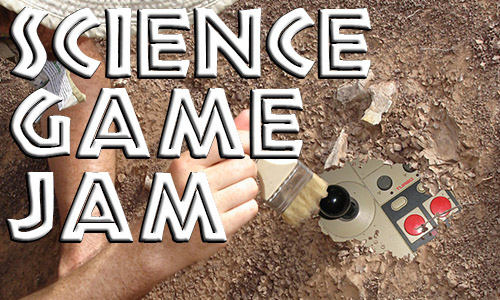
Long before any part of the event was planned, I mentioned that something of the kind might happen on the IGDA Chicago page, and to the Indie City Games group (the two biggest forces in Chicago's game scene). The amount of enthusiasm I received was overwhelming. It was as if all the game devs in Chicago shouted YOU MUST DO THIS.
The manager of BioSynC, Audrey Aronowsky, and I planned it out and put up an Eventbrite page. Despite being nearly a month before the event, the tickets sold out within the first three days, and later dropouts were replaced quickly. Even so, I was skeptical about the attendance of people who sign up for a free event, but when all was said and done 90% of those who signed up actually came.
On the day we started, everyone arrived and immediately chowed down on Indian food. This alone should tell you how atypical this game jam was. Audrey insisted that the event be catered and comfortable.
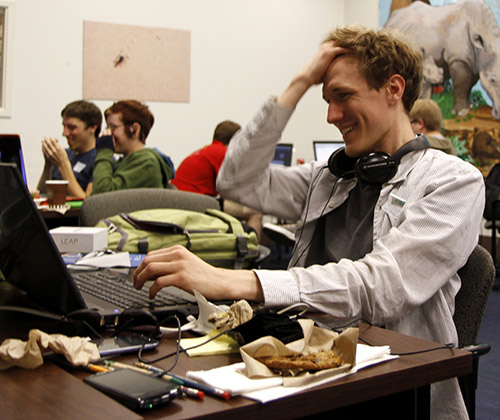 Developer Stephen Meyer struggles to ignore a half-eaten cookie.
Developer Stephen Meyer struggles to ignore a half-eaten cookie.
When everyone was settled, 8 scientists took the stage in turns: Courtney Stepien, Aaron Olsen, Tim Sosa, Jonathan Mitchell, Tom Stewart, Joanna Mandecki, Max Winston and Dave Clarke . These are early-career scientists; still passionate about their field and open to new ways to bring their science to the public. Each had 5 minutes to describe his or her research. The organisms studied ranged from Algae to Army Ants to Pirahna, but there were underlying questions that many of the researchers shared. Why did this trait evolve the way they did? How do these species interact with one another? The game developers had a lot of questions, too. Some were whimsical, others showed a deep interest in the scientist's work.
Then came the whirlwind process of team formation. I asked each group of developers to come up to the front with a list of names of developers on their team, and then to request a specific scientist to join their team. As written, this sounds like a neat and orderly process, but the reality was far from organized. People scrambled to pull together their teams in order to claim 'dibs' on the scientist of their choice.
For the rest of that Friday night, while the party people of Wrigleyville and Wicker Park danced and drank and forgot their phones in the bathroom, a gang of game developers gathered inside a museum to grill a scientist on the details of the Rove Beetle's mandible structure and the eating habits of the modern-day Raptor.
Game developers and scientists worked so well together, it was as if the two disciplines were separated at birth and reunited. In a manner of speaking, they have the same parents: systems and rules. They spent the night learning about each other's systems, each others rules, and found the descriptions eerily similar. It was an inspiring night, when the game they made that weekend could still be anything, and there were no such thing as programming errors or compatibility issues.
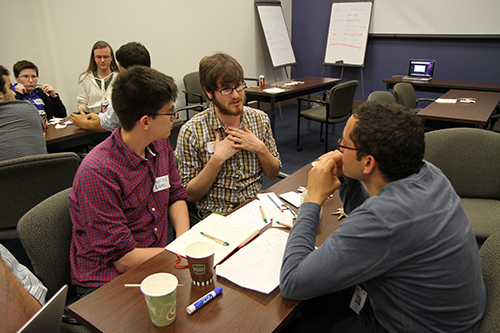 A scientist and a game designer learning each other's language.
A scientist and a game designer learning each other's language.
Some teams dove in immediately - catching only a few winks on the floor over the course of a long night. Some went home to sleep in their beds one last time, and to reflect on their game concepts.
Teams varied widely. Some were basically a loose collection of mavericks working towards a common goal, like Rachel Ponce and her 'Army Ants' team. Some were formed around a set of people who work together often, like The Men Who Wear Many Hats. Some participants were hardcore veteran Game Jammers, like Dave "Jacksmack" Fulton. Some were new to the idea of a game jam, like artist Pui Che. One team decided against making a digital game entirely, instead crafting a board game. That team had just two people, Chris Klein and Brian Gabor. Some had as many as six, not including their chosen scientist. Game developers in Chicago are not a small group of people, but we're pretty tight-knit. I previously knew or had met around 75% of the people who participated. The rest, I'm glad I know now.
The next day, I asked Patrick Hoover to come in and talk to each of the teams. Patrick is an instructional designer at the Chicago Quest middle school, and spends a lot of time assessing the educational merits of particular game designs. I sat in on a few of his meetings. It was fascinating to me how he made it clear which directions were most promising pedagogically without ever offering an overt suggestion. "Oh, it's really fascinating that you chose to emphasize that," he'd say, by way of encouragement. Good friend Andy Saia also dropped by on Saturday to act as a troubleshooter for those who had gotten themselves in technological trouble. I think people mostly appreciated the assistance these two experts brought, though no one would have faulted a team that wanted to be left alone for the sake of productivity.
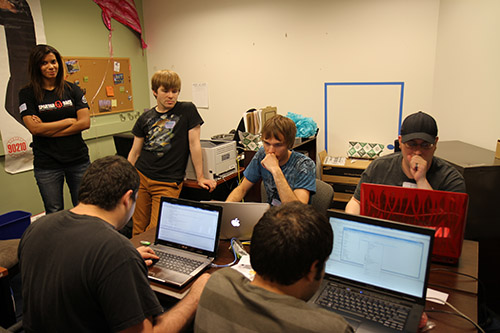 The team behind "The Tide" had show-and-tell every few hours and literally applauded each other's achievements. They became known as 'the team that claps.'
The team behind "The Tide" had show-and-tell every few hours and literally applauded each other's achievements. They became known as 'the team that claps.'
We closed the venue on Sunday morning at 2AM, sending a few die-hards and out-of-towners to a nearby hotel until 6AM at the earliest. It was a refreshing mandatory break that allowed everyone to progress much faster on the third day. Games actually started to look like games as new art and gameplay features were added. Moods brightened. "We'll have something to show," more than one game developer told me with a smile on their face.
At 5PM, it was pencils down. For the first time since the scientists gave their presentations on Friday, we gathered everyone in one place.
Judges arrived. I'm proud to have gathered an amazing group of judges to weigh in and give their opinions of the games. The judges were Ken Angielczyk, Curator of Paleomammology at the Field Museum, Jay Margalus, President of Lunar Giant Studios, Kyle Bailey, Lead Programmer at Phosphor Games, and Jake Elliot, Designer at Cardboard Computer.
Just as the scientists each had five minutes to summarize their research, game development teams each had five minutes to summarize their games. Five minutes in, five minutes out. This was the first time some of the developers saw what their colleagues had been working on. We paused for dinner, and to deal with the unavoidable technical problems that come with connecting so many machines to a projector in sequence. When the presentations were over, there was palpable relief in the air. The hard part was over.
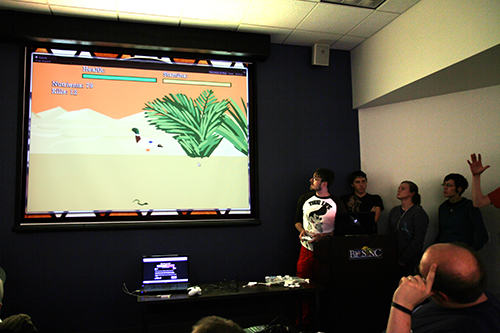 Ryan Wiemeyer presents for his team, "Birds Eat Everything"
Ryan Wiemeyer presents for his team, "Birds Eat Everything"
The judges gathered in an outlying conference room to deliberate. There were three prizes awarded: The Jury Prize, selected by the judges, the Science Prize, selected by the consensus of participating scientists, and the People's Choice, selected by a vote taken among the game developers. The three prizes were awarded with a lot of applause and enthusiasm, but everyone recognized them as tokens of an achievement they all shared. Every person who participated made a game (hard) in 48 hours (brutal) about a topic in biology (impossible). Through a thin layer of fatigue, you could see pride on everyone's face as we all said our goodbyes.
Game Jams always feel like a bubble in reality, or an alternate dimension. A place you can go, but you can't stay. It almost feels as if time stops during a game jam, and your friends and loved ones outside continue to age while you trade immortality for isolation. But, knowing that it cannot last, the game jam can be glorious, and this one was doubly so. Thanks to Audrey Aronowsky, the Biodiversity Synthesis Center, the Field Museum, the amazing judges, the fantastic scientists and everyone who participated. It was a weekend we can all be proud of.
You can view the entire game jam on youtube here, and 8 more polished short documentaries are being produced by the Biodiversity Synthesis Center and will be available shortly.
Robert Lockhart is Creative Director (and nearly everything else) of the Educational Games Studio Important Little Games. You can follow him on twitter @bobbylox
Read more about:
Featured BlogsYou May Also Like